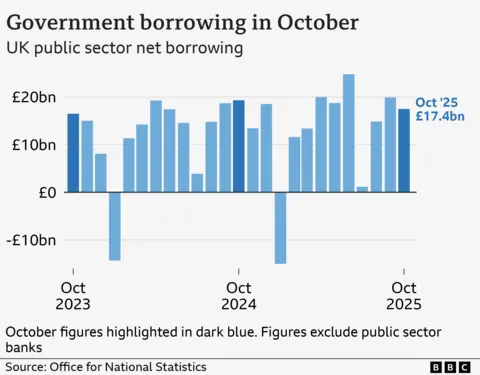Business
Government borrowing for October higher than expected

Rachel ClunBusiness reporter
 Getty Images
Getty ImagesUK government borrowing was higher than expected last month, according to the latest official figures.
Borrowing – the difference between public spending and tax income – was £17.4bn in October, the Office for National Statistics (ONS) said, which was above analysts’ forecasts of about £15bn.
The borrowing figures come less than a week before Chancellor Rachel Reeves unveils her Budget, and she has previously confirmed both tax rises and spending cuts are on the table.
Separate figures from the ONS showed retail sales fell in October, with some retailers saying that shoppers were waiting for this month’s Black Friday deals.
Ruth Gregory, deputy chief UK economist at Capital Economics, said that together the latest government borrowing and retail sales figures painted a “pretty grim picture” of the economy.
Although October’s borrowing figure was above expectations, it was £1.8bn lower than the figure seen in the same month last year.
“While spending on public services and benefits were both up on October last year, this was more than offset by increased receipts from taxes and National Insurance contributions,” said ONS chief economist Grant Fitzner.
Despite the fall, it was still the third-highest October borrowing figure since monthly records began in 1993.
In the financial year to October, borrowing was £116.8bn, which was £9bn more than the same period in 2024. It was the second-highest borrowing for April to October since records began in 1993, after 2020.

James Smith from investment bank ING said the borrowing figures would not be welcomed by the chancellor ahead of her Budget, but said her fiscal rules were about what happens later this decade, rather than the current picture.
“Today’s data is not helpful, it shows that the government is borrowing more than expected, but it doesn’t necessarily change the decisions next week,” he told the BBC’s Today programme.
Nick Ridpath, research economist at the Institute for Fiscal Studies, noted government borrowing for the year to date had continued to exceed forecasts from the OBR, “to the tune of around £10bn”.
Mr Ridpath said that while the borrowing figures should not be given too much weight, ahead of the Budget they highlighted the uncertainty around pressures on spending and tax revenues and the “stubbornly high costs of servicing government debt”.
The chancellor needs to find more money in her 26 November Budget to meet her self-imposed rules for government finances, which she has described as “non-negotiable”.
The two main rules are:
- Not to borrow to fund day-to-day public spending by the end of this parliament
- To get government debt falling as a share of national income by the end of this parliament
The BBC understands that newer assessments from the OBR have put the gap in public finances that Reeves needs to fill at £20bn.
Mr Ridpath said: “Operating with minimal fiscal margin for error is risky, and this is one reason why the chancellor might sensibly take steps to increase her so-called ‘fiscal headroom’ at next week’s Budget.”
Chief secretary to the Treasury James Murray said the government aimed to reduce borrowing over the course of the parliament, with £1 of every £10 in taxpayer money currently spent on paying interest on national debt.
“That money should be going to our schools, hospitals, police and armed forces,” he said.
“That is why we are set to deliver the largest primary deficit reduction in both the G7 and G20 over the next five years – to get borrowing costs down.”
Shadow chancellor Sir Mel Stride said borrowing so far this financial year had been the highest on record outside the pandemic.
“If Labour had any backbone, they would control spending to avoid tax rises next week,” he said.
The ONS also released data showing that over the month of October retail sales fell by 1.1% – the first monthly drop since May.
“Supermarkets, clothing stores and online retailers all saw slower sales, with feedback from some retailers that consumers were waiting for November’s Black Friday deals,” Mr Fitzner said.
Ruth Gregory at Capital Economics noted the monthly fall in retail sales “isn’t quite as bad as it looks” as it comes off the back of four consecutive months of increases, but also said that consumer confidence had declined, which “suggests that consumers aren’t exactly chipper at the moment”.
Business
Markets reforms: Govt to table Securities Markets Code Bill in Winter session; unified law to merge Sebi, Depositories & trading Acts – The Times of India

The government has listed the Securities Markets Code Bill 2025 for introduction in the Winter session of Parliament starting December 1, according to a Lok Sabha bulletin. The unified legislation is aimed at boosting ease of doing business and reducing regulatory friction across India’s financial markets. The Bill proposes merging key securities laws, including the Securities and Exchange Board of India Act, 1992, the Depositories Act, 1996, and the Securities Contracts (Regulation) Act, 1956, into a single code. The unified framework was first announced in the Union Budget 2021-22, when Finance Minister Nirmala Sitharaman proposed consolidating multiple laws governing securities markets — including the Government Securities Act, 2007 — into a rationalised code. Experts said the move could reduce compliance costs and minimise overlaps between rules enacted by Sebi, depositories and the central government. Bringing the Government Securities Act within a unified code could also strengthen credibility of sovereign borrowing and help channel more foreign capital, they noted.
Business
Index reshuffle: IndiGo parent to enter Sensex from Dec 22; Tata Motors Passenger Vehicles dropped – The Times of India

InterGlobe Aviation, the operator of IndiGo, will be included in the BSE’s 30-stock benchmark index Sensex from December 22, the BSE Index Services said on Saturday.As part of the reconstitution exercise, Tata Motors Passenger Vehicles Ltd will be dropped from the index, the announcement added, PTI reported.The changes will take effect from market open on Monday, December 22, and have been made by BSE Index Services Pvt Ltd (formerly Asia Index Pvt Ltd).In the broader BSE 100 index, IDFC First Bank Ltd will be added, replacing Adani Green Energy Ltd. Within the BSE Sensex 50 index, Max Healthcare Institute Ltd will be included, while IndusInd Bank Ltd will be removed.Further, in the BSE Sensex Next 50 index, IndusInd Bank and IDFC First Bank will replace Max Healthcare Institute and Adani Green Energy.
Business
India’s New Four Labour Codes: From Gratuity After One Year To Free Annual Health Checkups; Who Will Receive Gratuity In Case Of Private Sector Employee’s Death?
)
New Labour Codes In India: The Government of India has introduced a major reform that will benefit lakhs of employees who frequently change jobs, including fixed-term employees, women, gig workers, MSME staff, and contract workers. Under the new Labour Codes, the minimum service required to receive gratuity has been reduced from five years to just one year. This means more workers will now be eligible for gratuity even if they don’t stay long in one organisation.
This major reform is part of the government’s plan to replace 29 old labour laws with four new Labour Codes. These include the Code on Wages, the Industrial Relations Code, the Social Security Code, and the Occupational Safety Code, replacing outdated regulations framed between the 1930s and 1950s. The goal is to make business processes smoother, improve worker welfare, update outdated rules, and create a more transparent and worker-friendly labour system.
Gratuity: What It Is And What Happens After Private Employee’s Death
It is a one-time amount that employers give to employees as a thank-you for their service. Under the Payment of Gratuity Act, private sector employees can receive gratuity when they leave a job (due to resignation or termination), retire, or become disabled. In case of an employee’s death, the amount is paid to their nominee. Earlier, employees had to complete at least five years of continuous service with the same employer to be eligible, except in situations of death or disability. (Also Read: What Is EPS-95 Scheme? If Employee Becomes Permanently Disabled, Will He Get Pension? Check Benefits, Eligibility Criteria, And How It Is Calculated)
New Labour Codes: How New Gratuity Rule Strengthens Worker Security?
With this reform, employees will not be penalised for having short job tenures, giving young workers who often switch jobs better financial security. It also benefits contractual, fixed-term, and gig workers by making gratuity easier to receive and more predictable. By offering gratuity to more people, the government is encouraging formal employment and improving the safety net for all workers. Overall, this change makes India’s workforce more secure and brings labour benefits closer to global standards.
New Labour Codes: Benefits Including Free Annual Health Check-Ups
For the first time, all workers, whether permanent, contractual, or fixed-term, must receive appointment letters, which improves job security and helps reduce disputes. The new Labour Codes also make preventive healthcare mandatory, requiring employers to provide yearly health checkups for workers aged 40 and above, helping with early detection and lowering long-term health risks.
Under the Code on Wages, every worker across all sectors is now entitled to minimum wages, ensuring that no one falls below a basic income level. Adding further, women are allowed to work in all types of jobs, including night shifts, giving them greater employment opportunities and flexibility.
-

 Tech1 week ago
Tech1 week agoNew carbon capture method uses water and pressure to remove CO₂ from emissions at half current costs
-

 Politics1 week ago
Politics1 week agoBritish-Pakistani honoured for transforming UK halal meat industry
-

 Business1 week ago
Business1 week agoThese 9 Common Money Mistakes Are Eating Your Income
-

 Sports7 days ago
Sports7 days agoTexas A&M officer scolds South Carolina wide receiver after touchdown; department speaks out
-

 Tech1 week ago
Tech1 week ago$25 Off Exclusive Blue Apron Coupon for November 2025
-

 Sports1 week ago
Sports1 week agoApple scrapping MLS Season Pass service in ’26
-

 Fashion1 week ago
Fashion1 week agoAfter London, Leeds and Newcastle, next stop Glasgow for busy Omnes
-

 Business1 week ago
Business1 week agoWhat’s behind Rachel Reeves’s hokey cokey on income tax rises?







